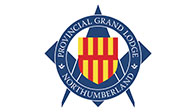Today we help the Brethren of Segedunum Lodge No. 4313, which meets at Wallsend Masonic Building, with their centenary celebrations.
The Romans perhaps had more to do with the North East, militarily, than any other conquering nation.This is reflected in the names of many of our local communities which were Roman in origin, and through the years, have become Anglicised.
From the Solway Sands to the Mouth of the Tyne, one of the greatest defensive structures every known wended its way through the Cumbrian and Northumbrian countryside, built on the orders of, and perhaps supervised in part, by the Emperor Hadrian himself. That structure came to a terminus on the banks of the Tyne, and was named Segedunum, which means ‘Strong Fort’, but when the Romans left, a small village and community grew up in an area away from the Fort, and may have been called Valeshead. However, years later, this was further corrupted or changed, to a name about which there can never be, never has been, nor ever will be any doubt : The Wall’s End. The End of the Roman Wall, the final and uttermost limit of the Roman Empire.
Wallsend, the Fort of the Fourth Cohort of Lingones, was a key element in the consolidation of Hadrian’s sprawling Empire. Along with the neighbouring Fort of Arbeia, later South Shields, it formed an important link in the supply chain to the other Forts on the Wall. In general, the Roman rule, was for the most part, beneficial. Local religions and political movements were tolerated, and allowed to continue, as long as local people acknowledged the Divinity of Caesar.
One Cult which the Romans introduced, possibly by way of Persia, was the Cult of Mithras. The Cult of Mithras in many ways, paralleled Freemasonry, for prospective candidates had to progress through a series of Grades or ‘Degrees’. Indeed, modern reconstruction show Temples to Mithras were laid out very much like Lodge Room, with Columns, Pedestals and Altars. There seems little doubt, that had Christianity failed, and did not, in time, become the official religion of the Roman Empire, Mithraism , but for better or worse, no one knows.
The decline of the Cult of Mithras was no doubt due to the influence of the early Christian Church, and where the Cult flourished, it was condemned and driven underground. The leaders of the Church were afraid of a possible revival of the Cult, and so condemned all secret societies and forbade meetings. The fears of a possible revival and destabilising of the Church were groundless, for the Roman Empire was hurrying towards its end.
When consideration was given to the formation of a new Lodge in Wallsend, in 1921, during a series of Founders’ Meetings, W Bro. Alfred Dowsland, who was known to be interested in Roman History, suggested that the name and motto of the Lodge could be taken from the Roman connections in the North-East. A number of names were considered, including Paulinius, Chesters, and Corstoptitum. The latter two names were rejected as being geographically inaccurate, (although Corstopitum was to be used for another Lodge much later). Finally, the name Segedunum was selected, with the Motto ‘ Out of darkness into light’ which retained on the Summons, rather than the original Latin ‘ Qui dixit de tenebis in lucem’. Also included on the front of the Summons was an illustration, taken from a stone effigy in a Newcastle Museum, depicting the God Mithras, emerging from an egg, bearing the above Latin inscription. This was approved both at Grand Lodge and Provincial Grand Lodge, and the Founders felt that they could move apace with the arrangements. There were 22 Founders who put the names to the Petition for the new Lodge, which was sponsored by Holy Cross Lodge No 3679, and the Warrant was dated 13 June 1921, with the Consecration following on 29 July 1921.
The first Worshipful Master was W Bro. William Jackson Clark, a PM of Neptune Lodge No 2908; the first Senior Warden was Bro. George Henry Cameron of Tyne Lodge No 991, and the first Junior Warden was Bro. George Hill, also of Tyne Lodge No. 991. The Provincial Grand Master, at the time R W Bro. Charles Warren Napier-Clavering, conducted the Consecration Ceremony at the Masonic Hall, Station Road, Wallsend.
There is some doubt as to which Ritual was originally used by the Lodge. From internal documentary evidence in the Provincial Library and Museum, it seems that the Ritual used in the Lodge was a mixture of two separate workings: ‘Hindson’ and ‘Smith’s’. This apparently did not go so smoothly as intended, so the Lodge was forced to use ‘Smith’s’ as the only Ritual in the ceremonies. It seems that ‘Smith’s’ Ritual eventually became ‘Northumbrian Past Master’s’ working, which is the one conducted by most Lodges in the Province in modern times. One custom of the Lodge, perhaps arising from these ritualistic confusions, was that of having the Warrant read in open Lodge once a year.
The Lodge, by the time it celebrated its Golden Jubilee in 1971, had, according to the records, received 415 new members, either as Initiates or as Joining Members. A major setback affecting the Lodge, and other Lodges, in 1961, was the destruction of part of the Masonic Hall by fire, but the Lodge came through, and continued, until the present day, full of good heart and spirits, and never ignored the repeated calls on its charity.
Thanks go to W.Bros Ian Brown, the Provincial Librarian and Archivist, and David Chilton, the Secretary of Segedunum Lodge, for the submission of this articole.
If you have a story, event or news item you would like to have published on the Provincial website, please get in touch with the Provincial Communications Team at news@northumberlandmasons.org.uk

